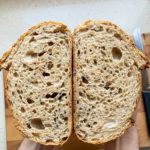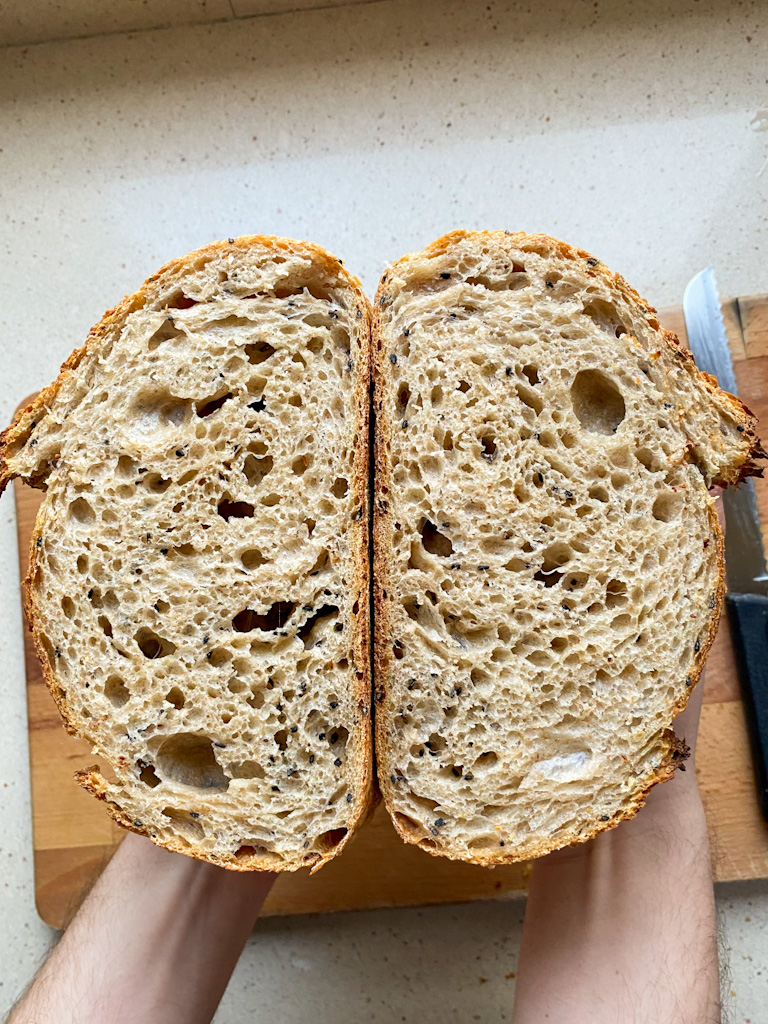Learn how to prepare this incredible sourdough bread made using orange-infused olive oil and sesame seeds.
This recipe is inspired by Kristen Dennis on her page Instagram page @fullproofbaking.
Which Oil Should I Use?
I highly suggest using a good quality extra virgin olive oil for this recipe that has been infused with orange. Many grocery stores keep it in stock in their store or online. However, you can also make it at home. I’m currently working on a how-to guide for infusing olive oil for recipes or enjoying it drizzled over bread.
If you prefer something more traditional, try my artisanal sourdough bread or 50% whole wheat sourdough bread.

Sourdough Bread with Orange-infused Olive Oil and Sesame Seeds
Learn how to prepare this incredible sourdough bread recipe made using orange-infused extra virgin olive oil and sesame seeds.
Author Stephanie K
Equipment
- Kitchen Scale
- Lame or sharp knife
- Dutch oven or oven-proof combo cooker
Ingredients
- 113 g Whole wheat flour
- 387 g Bread flour
- 343 g Water
- 16 g Orange-infused olive oil
- 100 g Active sourdough levain see notes after recipe on how to make a levain
- 12 g Salt
- sesame seeds
Instructions
- Autolyse: Combine both flours together with the water in a bowl until no dry bits of flour are left. Cover your bowl (with a lid, wet towel, plastic wrap, etc.) and let that sit in a warm place (25C/75F) for about an hour.
- Add in your levain and oil: Pour the sourdough starter and oil on top of your dough and with wet hands dimple and pinch it into your dough until it is all combined. You can mix it in various ways (rubaud method, slap and fold, etc.). Once everything has been incorporated, cover your dough again and leave for 10 minutes.After it is all incorporated, cover your bowl and set it in a warm place. For me, that means making sure the temperature is between 22C-27C (the warmer the temperature the faster it will ferment).
- Add in the salt: combine the salt with just 1 tsp of water and pour over the top of your loaf. Once again, dimple and pinch to mix it in until it is all combined. If you find your dough is really dry, you can add another 2 tsp of water to pinch in the salt. After it is all incorporated, cover your bowl and set it in a warm place. For me, that means making sure the temperature is between 22C-27C (the warmer the temperature the faster it will ferment).
- Bulk Fermentation: Perform 3 sets of stretch and folds at 30-minute intervals to help give your dough structure and help to further develop the gluten. Incorporate the seeds in the first set of stretch and folds.In total, bulk fermentation can last from 3.5 to 6 hours or more. Note: In my kitchen, when the temp is 27C or warmer I need to watch it because it might ferment as quickly as 3 hours. Whereas, if the temp is 23-25C it might take anywhere from 4-6 hours to ferment. It’s all about measuring the temperature of your atmosphere and seeing how your dough is affected.
- Pre-shape: Pre-shaping helps to give your dough even more structure and a bit of tension. If I am making just one loaf, my preferred method is to give the dough one last coil fold in the bowl and let it sit again covered for about 20 minutes. You can also do this on the counter. Wet the counter with a spray bottle or just drop water down. Turn it out of the bowl onto the counter and fold the outside into the middle and form it into a ball.
- Final Shape: Dry off your counter space and sprinkle a bit of flour down to prevent sticking. Fold your dough and place in your banneton. Here you have two options, you can leave it to proof for about 2 hours at a warm temperature, or you can let it sit and proof in the refrigerator to let the flavors develop even more. Note: leaving it in the fridge also makes it easier to score and helps it to have more oven spring. If you choose to leave it in the fridge, you can leave it anywhere from 2 to 48 hours.
- Bake: Preheat the oven 30 minutes, with the dutch oven inside, at 250C. Once the oven is hot enough, take the dough out of the fridge, turn it out onto parchment paper and give the dough a slice on the top (score) and place it in the dutch oven. Bake for 20 minutes with the lid on, then take the lid off to release the steam and get your crust crispy for 15 minutes and reduce the temp to 225C. Then take it out of the dutch oven, and place it alone on the rack for 15 minutes at 180C.The dough is finished cooking when the internal temperature reaches 95C/190-200F. Important: After taking it out of the oven, make sure to let your dough sit for at least 30 minutes to reduce a gummy interior.

